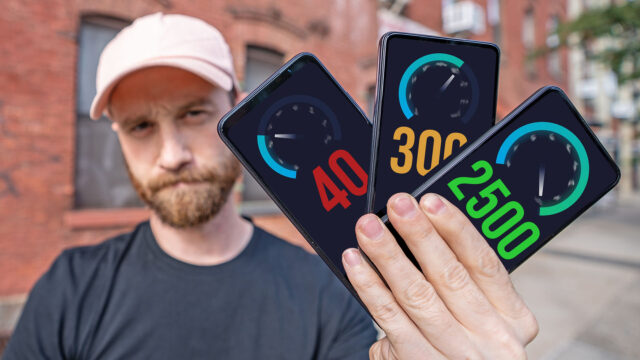Best External SSDs in 2020
I started using filming a few things on a new camera not too long ago: the Blackmagic Pocket Cinema Camera 6K. And as the name suggests, it can shoot in 6K (and in RAW format) all of that to say though that the files I’m working with because of it, are not small ones.
So, while I do have my Samsung T5 that I am a big fan of, the new camera did get me to start researching to see what newer external SSDs might now be available in 2020 that might be a good replacement. I then proceeded to buy quite a few of them to test them all out, as you do.

And now, I think I have a decent list of the 5 best external SSDs to buy.
So, first up, I had some specific criteria for what the best external SSD needs to meet:
- It has to be an SSD as I need faster speeds and just find them more reliable than HDDs anyway.
- I travel a ton so it has to be portable and the smaller (without sacrificing other features) the better.
- I need to be able to edit my footage directly off of it so it had to be fast enough to do that, even with 6K footage.
- Durability, price, etc. are also considered, of course.
Also just to the testing is clear, I’m using a Razer Blade 15 Studio Edition with a USB 3.2 Gen 2 Type-C port which also doubles as a Thunderbolt 3 port.
Samsung T7 Touch SSD

The first one I immediately went for, and honestly is probably already my favorite on the list is actually is the successor to my original drive: this is the Samsung T7 Touch.
Now, there is also a T7 model that is slightly cheaper but the model I grabbed is the word “Touch” added to the end and that’s because it also has a built-in fingerprint sensor directly on the side of the drive.

You can set this up using the included software on the drive to be able to then encrypt the drive and have it only accessible if you put one of the up to four fingerprints associated with the drive on the sensor (otherwise it shows a read-only folder).

As far as portability goes, it’s pretty small and encased it metal which feels nice. It’s a bit taller but also thinner than the T5 I had but has the same width just about. And that’s important for me and might be for any other T5 users.
The T5 was so popular honestly that a lot of companies began making accessories for various products that held the T5 like this handle from Smallrig that allowed you to slip the T5 inside it, or this mounting bracket to sit a T5 on top of your camera, etc. So if you happen to have any of these accessories, then that same width in a lot of cases means the T7 will fit well enough in the same accessories.

As for speed, the T7 managed about 940MB/s sequential read in Crystal Disk Mark and in my drag and drop test averaged around 570MB/s. And it’s still using the same top USB spec of USB 3.2 Gen 2 (a renaming of USB 3.1 Gen 2 by the way). Turns out the controller inside the device has been beefed up and is partly why the speed has increased.
That speed along with every other SSD on this list for that matter is enough for me to edit my 6K footage directly from the drive so I imagine whatever you need to do with it, it’ll handle it pretty well.

In the box, you get a short USB Type-C to C cable and a USB Type-A to C, as well. One thing I noticed that’s missing though is the little velcro tie that the T5’s two cables came with, but not the biggest deal, obviously.

The T7 Touch starts at $129.99 for the 500GB and you can check it out at the links below for the cheapest price I could find on it.
SanDisk Extreme Pro SSD

Next up, is the upgraded version to a drive that has become almost as popular as the T5: this is the SanDisk Extreme Pro.

And firstly, it’s slick and small. The SSD is a bit taller than the T7 and just a tad thicker. It’s made out of metal for protection and to dissipate heat but it’s covered almost entirely in silicon rubber and because of that, it’s actually dust and water-resistant to the tune of IP55: something the others on this list can’t claim.

Something else that was a point for the SanDisk Extreme Pro is that even though it’s rated for the same read/write speeds as the T7 for the most part (around 1000MB/s) it actually was faster than the T7 in both Crystal Disk Mark (955MB/s sequential read) and my drag and drop test (615MB/s or so) even if only just.
Just like the T7, it comes with a Type-C to C and Type-A to C cable in the box.
And even though SanDisk lists the SSD to support USB 3.1 Gen 2, again, it’s actually the same as the T7’s USB 3.2 Gen 2 (SanDisk maybe just didn’t get the memo to rename it).

You can buy the SanDisk Extreme Pro for $119 for the 500GB and that price that’s just $10 less than the T7 seems to me like SanDisk saw how popular the T5 was and decided to aggressively come after it. You can find out more about it at the links below.
Seagate Fast SSD

Next up, we have the Seagate Fast SSD (aptly named maybe).
With a 540/500MB per second advertised maximum read/write speed, it’s about half as fast as the first two on this list, but in Crystal Disk Mark, it still managed to get 560MB/s for sequential read and in my drag and drop still got 350MB/s for writing so it’s no slouch.
The case has an aluminum top you can see but the rest is plastic. Regardless, it still supports USB 3.0 (not 3.1/3.2 however) through a Type-C connection and comes with a USB Type-C to C and a USB Type-A to C cable in the box.

The real reason it’s on this list though is that it gives you decent speeds (enough to still handle any video editing) but it’s cheaper than the other two.
It starts at $84 for the 500GB ($40 less than the SanDisk), but that gap gets larger if you, say, go for the 2TB option for just $249 compared to $429 for the SanDisk and $399 for the T7 Touch.
Western Digital My Passport SSD

This is the Western Digital My Passport SSD and it’s very similar to the Seagate SSD.

Same 540/500 MB/s read/write speeds (340MB/s in my drag and drop and 540MB/s in the Crystal Disk Mark sequential read), same USB 3.0 Type C connection (but it comes with one USB-C cable and a USB-C to A adapter instead of two separate cables, and it’s even similarly priced.
The 512GB option is about $90 at the time of making this video and the largest 2TB option is $280.

The reason I added it to this list comes down to the fact that it’s nicer looking than the Seagate and that it’s just so darn tiny.
Samsung X5 SSD

Moving on, this last SSD is a bit of a stretch on this list honestly. I wanted to put it on here though because it’s also become super popular for a number of reasons. It’s the Samsung X5.

It’s encased in metal so it’s pretty durable and it has a theoretical 2800MB/s read and 2300MB/s write speeds (as in 2.8 and 2.3 GB/s).
One of the reasons for those speeds is that it’s Thunderbolt 3 capable (and comes with a short Thunderbolt 3 cable, by the way). This means it has a much larger pipe it can send data through. It also means that you can only get those speeds if you are using a computer that has a Thunderbolt 3 USB-C port on it.
The biggest downside to this drive though is the price. The 500GB is $200, the 1TB is $350, and the 2TB is a whopping $700.

But, if you want the fastest you can get and have the extra cash to spend, it’s a good option to at least consider.
You can check it out at the links below.
And there you go, the best external SSDs for 2020. Let me know what you guys think in the comments below and don’t forget to subscribe to my email newsletter here.
Thanks for reading!





















But how does the T7 compare to the T5? Beyond the fingerprint, is there anything the T5 can’t do the T7 can?
It’s faster. Theoretical speeds doubled from 500 and something to about 1000MB/s